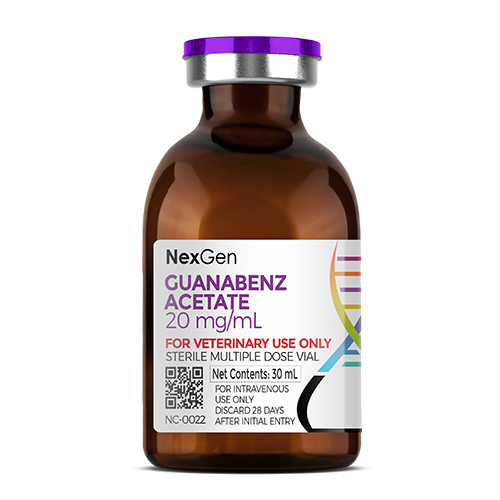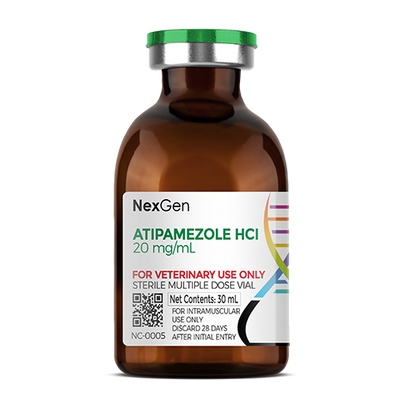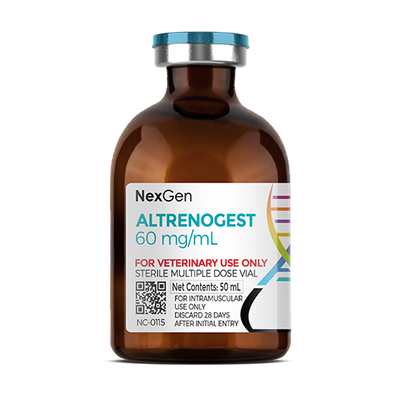
Guanabenz Acetate 20 mg/mL, Injectable, (30mL)
Login for pricing
- Brand
- Mixlab
- SKU:
- NC-0022
- Product Type:
- Injectable
- Size:
- 30ml
- Administration:
- Intravenous
- Therapeutic Class:
- Anesthetic, Sedative Alpha2-Agonist
Guanabenz
Guanabenz (also known as extraneal or adept) belongs to the class of organic compounds known as dichlorobenzenes. Dichlorobenzenes are compounds containing a benzene atom with two chlorine atoms attached to it.1 Guanabenz is an α-2 selective adrenergic agonist that is commonly used as an antihypertensive agent. Guanabenz's antihypertensive effect is thought to be due to central alpha-adrenergic stimulation, which results in a decreased sympathetic outflow to the heart, kidneys, and peripheral vasculature in addition to a decreased systolic and diastolic blood pressure and a slight slowing of pulse rate. Chronic administration of guanabenz also causes a decrease in peripheral vascular resistance.2
Guanabenz is increasingly being used in racing and other performance horses as a calming agent, and to take the edge off excitable and overly anxious horses to improve their focus and manageability. Guanabenz is a superior solution to the harsher psychotropic drugs which some horse owners have used to help horses through stressful situations.
The Origins of Nervousness in Horses
Horses were born to run, and the specialized breeding and training in equestrian circles, as well as the demands on horses, have given rise to animals that can be skittish to varying degrees. Survival instincts drive horses to move faster in response to fear and anxiety, and even mundane activities can trigger their instinctive flight response. Even those who frequent riding stables will be familiar with the habit of managers identifying less experienced riders in a party so that these can be put on less skittish horses.
It is the job of trainers and handlers to take performance horses and train them to perform to the best of their abilities without pushing them beyond their mental and physical limits. An unfortunate byproduct of these phenomena is that many performance horses have been subjected to the administration of behavior-altering drugs that allow owners and handlers to keep their horses “at the brink,” so to speak, without sending them over the edge.
Most of the behavior-altering drugs used in the horse industry today have come from human medicine. Acepromazine, chlorpromazine, fluphenazine and reserpine are antipsychotic drugs used to treat mental illnesses such as schizophrenia and bipolar disorder. Guanabenz is an antihypertensive used to control blood pressure.
These calming agents are generally used to take the edge off excitable and overly anxious horses to improve their focus and manageability, thus their performance. While some barrel racers use psychotropic drugs temporarily to help horses through stressful situations—like experiencing fireworks and Ferris wheels at rodeos and parades, for example. There are also horses that never perform or compete without some sort of chemical assistance.
Behavioral Management
There are many methods of dealing with a nervous horse. Though it may not be possible to definitively identify what is causing a horse's skittishness, it can be helpful to isolate any such stimuli when possible, since addressing these directly could go a long way toward resolving the issue. Very often however, the basis for a horse's nervousness may be a function of temperament, or some stimulus that cannot be identified.
The first option is usually behavioral management, or training. Like many domesticated animals, horses forge relationships with their handlers, and tend to be more comfortable with people they know. These days, there is a great deal of information available (articles, blogs, message boards) wherein seasoned horse owners, managers and veterinarians offer their experience and expertise in the area of managing the nervous horse through behavior modification. This usually involves various exercises and drills that are calculated to incrementally diminish nervousness in the horse.
When behavior modification doesn’t do the trick, there are calming supplements that appeal to many horse owners. There are currently numerous branded calming supplements available for horses on the market, all reported to help the horse be quieter, less reactive, and more able to focus. These are available in powder, pellets, granular, paste, liquid, and sometimes as wafers. Most contain an assortment of vitamins, minerals and even herbal remedies. Depending on the form, they can be given to horse directly or during mealtime.
Drugs and Behavior Management in Horses: Risks and Restrictions
Some veterinarians have hypothesized that the use of tranquilizers and sedatives (such as acepromazine) that facilitate muscle relaxation may also make horses more prone to soft tissues injures. The idea behind this is that ligaments take up some of the weight-bearing duties for overly relaxed muscles, making them more susceptible to injury.
While the use of drugs like acepromazine to the take the edge off of performance horses is a common practice in some areas, no studies of the long-term effects of its use in this manner have been carried out.
Currently, all the drugs previously mentioned are banned drugs, meaning they cannot be found in any level in a horse’s system under International Federation for Equestrian Sports (FEI) rules, acepromazine being the only exception. FEI lists acepromazine as a control substance, meaning that it must be used under strict guidelines.
The American Quarter Horse Association (AQHA) and the United States Equestrian Federation (USEF) both have judicious-use guidelines. The AQHA has guidelines for the use of medications such as phenylbutazone, diclofenac, flunixin, ketoprofin, furosemide, isoxsuprine, dexamethasone and other drugs. As regards drugs like tranquilizers, sedatives and performance enhancers, these are strictly forbidden as they “depress the cardiovascular, respiratory or central nervous system.”3 The National Reined Cowhorse Association, National Reining Horse Association and National Cutting Horse Association all have similar policies in place.
A Superior Solution
Compared to drugs like detomidine, guanabenz acetate is a long-acting and rapidly reversible sedative. While detomidine may last less than an hour, the effects of guanabenz at sedative levels can last for several hours. The efficacy of guanabenz as a calming agent in performance horses was studied by researchers at the University of Florida. In a paper published in the August 2006, researchers concluded that guanabenz did induce signs of adrenergic suppression.2
Guanabenz first drew the interest of racetrack veterinarians who were looking for alternatives to the diuretic furosemide. Guanabenz produces a rapid acting and long lasting sedative and analgesic effect in a subject animal that is selectively reversible. The use of guanabenz in the horse provides for a safe, effective, long lasting and rapidly reversible sedative and analgesic which can be used on the standing animal.4
Guanabenz is increasingly being used in racing and other performance horses as a calming agent, and to take the edge off excitable and overly anxious horses to improve their focus and manageability. Guanabenz is reported to be a superior solution to the harsher psychotropic drugs which some horse owners have used to help horses through stressful situations and to reduce nervous behavior.2,4
Pharmacology
The antihypertensive action of guanabenz appears to be mediated via stimulation of central alpha adrenergic receptors, resulting in a decrease of sympathetic outflow from the brain at the bulbar level to the peripheral circulatory system.4
The acute antihypertensive effect of guanabenz occurs without major changes in peripheral resistance, but its chronic effect appears to be a decrease in peripheral resistance. A decrease in blood pressure is seen in both the supine and standing positions without alterations of normal postural mechanisms, so that postural hypotension has not been observed. In humans, guanabenz decreases pulse rate by about 5 beats per minute. Cardiac output and left ventricular ejection fraction are unchanged during long-term therapy.5
Pharmacokinetics
In human studies, it was shown that approximately 75% of an orally-administered dose of Guanabenz acetate is absorbed and metabolized with less than 1% of unchanged drug recovered from the urine. Peak plasma concentrations of unchanged drug occur between two and five hours after a single oral dose. The average half-life for Guanabenz is about 6 hours. The site or sites of metabolism of Guanabenz have not been determined.5
Drug Interactions
Guanabenz has not been demonstrated to cause any drug interactions when administered with other drugs, such as digitalis, diuretics, analgesics, anxiolytics, and antiinflammatory or antiinfective agents, in clinical trials. However, the potential for increased sedation when Guanabenz is administered concomitantly with CNS-depressant drugs should be noted.5
Adverse Effects
In humans, the incidence of adverse effects has been ascertained from controlled clinical studies conducted in the U.S. and is based on data from 859 patients who received Guanabenz for up to 3 years. There is some evidence that the side effects are dose-related.
The table shows the incidence of adverse effects occurring in at least 5% of patients in a study comparing Guanabenz acetate to placebo, at a starting dose of 8 mg b.i.d.
| Adverse Effect | Placebo (%) n=102 | Guanabenz acetate (%) n=109 |
| Dry mouth | 7 | 28 |
| Drowsiness or sedation | 12 | 39 |
| Dizziness | 7 | 17 |
| Weakness | 7 | 10 |
| Headache | 6 | 5 |
Other adverse effects were reported during clinical trials with Guanabenz but are not clearly distinguishable from placebo effects and occurred with a frequency of 3% or less:
- Cardiovascular-chest pain, edema, arrhythmias, palpitations.
- Gastrointestinal-nausea, epigastric pain, diarrhea, vomiting, constipation, abdominal discomfort.
- Central nervous system-anxiety, ataxia, depression, sleep disturbances.
- ENT disorders-nasal congestion.
- Eye disorders-blurring of vision.
- Musculoskeletal-aches in extremities, muscle aches.
- Respiratory-dyspnea.
- Dermatologic-rash, pruritus.
- Urogenital-urinary frequency, disturbances of sexual function (decreased libido, impotence).
- Other-gynecomastia, taste disorders.
- In very rare instances atrioventricular dysfunction, up to and including complete AV block, has been caused by Guanabenz.5
Where to buy Guanabenz
Guanabenz is available in the U.S. through several pharmaceutical manufacturers and through veterinary custom compounding companies.
FOR RX ONLY: A valid prescription from a licensed veterinarian is required for dispensing this medication.
1nih.gov.
2O'Connor, D. Calming the Axious Horse. Equus Magazine, April, 2015.
4Tobin, T. Long Acting, Reversible Veterinary Sedative and Analgesic and Method of Use. (2006).Veterinary Science FacultyPatents. 14.


















